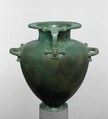Bronze hydria (water jar)
This is one of the earliest of this kind of Archaic Greek bronze hydriae to have survived. The handles are cast. Portions of the hammered bronze body are a modern restoration. The three handles are particularly decorative, especially for this early period. The vertical handle has a pair of lion heads at the top whose features are rendered with a combination of volumetric modeling and chasing. A woman's head, shown from the neck up, appears at the bottom. Six long, hatched braids frame her face on both sides and she wears a headdress known as a polos, on top of her head. The polos typically is worn by goddesses. Two half-spools extend perpendicularly from the woman's head on both sides, each ornamented with pairs of chased lines. The strap of the handle is covered with chased geometric patterns. The side handles have swan heads with long, rounded beaks at the outer edges. The straps of the handles and the half-spools that extend perpendicularly from the swan heads are ribbed with pairs of chased lines, as on the vertical handle.
Due to rights restrictions, this image cannot be enlarged, viewed at full screen, or downloaded.
This artwork is meant to be viewed from right to left. Scroll left to view more.



